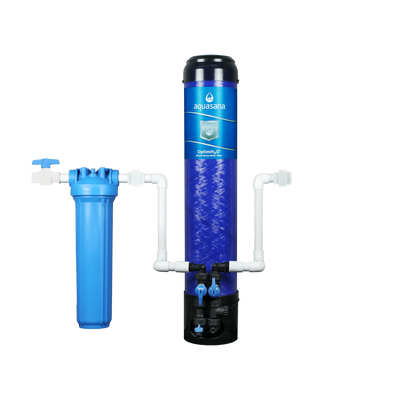When water goes into your home through a filter, you should have confidence that clean, healthy water will pour into your glass. When you have a reliable whole house water filter, you don’t have to worry about unseen chemicals, bacteria, or other contaminants getting into your body either through your drinking water or via inhalation from your shower.
But, to make certain you are filtering out even the smallest of particles, you need to ensure the micron level of your whole house water filter system is appropriate. Determining that can be confusing so below is a handy micron guide for you.
Let’s start with the basics.
How big is a MICRON?
A micron (μm) is a unit of measurement that stands for one micrometer or one-millionth of a meter. 1 micron is equal to 0.00004 inches or .0001 cm, and it’s often used to define the size of water contaminants. A micron level is what size of contaminant the filter in question can remove. Micron levels in water filtration are usually between .5 and 5 microns.
For example, if bacteria in your water are 1 micron and you have a filtration system with a micron level of 1; it will be able to filter out that bacteria (as well as anything larger than 1). However, any filter with a micron level greater than 1 will allow the bacteria to pass through and remain in your water.
For size reference, a human hair is as large as 70 microns while a piece of household dust can be 40 microns, and white blood cells can be as small as 25 microns while an average human red blood cell is about 5 microns. Any particle smaller than 50-60 microns is too small to see with the naked eye.
Interesting how substances so small can make such a large impact on your body, your health, and your peace of mind!
Micron levels in water filtration are usually between .5 and 5 microns.”
But this is just a part of the story. How does this play into your whole home filter system?
Microns are important at every step of filtration
Whole home filters typically involve a multi-step process in filtering your water from contaminants of all micron sizes like bacteria, sediments, and silt.
First, the water will start in the pre-filter process that works to remove larger particulates, impurities, and contaminants found in your tap water. Keep in mind the size of the particles that it removes at this stage – many sediment pre-filters are equipped to handle particles down to 1 micron.
Then, the water will filter into the main filter, which can be made of different filtration materials or media. Let’s use our Aquasana OptimH2O® Water Filter System as an example. Its main filter contains a huge, ultra-dense carbon block. This block combines catalytic and activated carbon to perform ion-exchange and sub-micron filtration. But what does that all mean?
The system provides first-of-its-kind effectiveness to reduce lead and PFOA/PFOS. It also removes chlorine and chloramines from your water that your municipality uses to treat the water. Chlorine and chloramines often have remarkable staying power, and can damage skin and hair, as well as be a cause for concern for those who suffer from asthma. In the OptimH2O®, the carbon block filters down to 0.5 microns and is so powerful that a post-filter isn’t even needed.
As another example, our Rhino® whole house water filter systems have dual main tanks. The bottom of the tank is an activated carbon filter that reduces herbicides, pesticides and other chemical compounds. The top of the tank holds copper-zinc and mineral stone to reduce chlorine, water-soluble heavy metals and more.
The RHINO® systems can be upgraded with a third step — a post filter that acts as a polishing agent to catch any remaining sediment in your water.
Micron levels play a key role at every stage of the process. Without this unit of measurement, we wouldn’t know how to properly eliminate particles that can’t be seen without a microscope.
FILTER DOWN TO THE SMALLEST MICRON ACROSS YOUR WHOLE HOME
You may have realized by now, but the lower the micron level of a filter, the more contaminants it can catch and purify from your water. So be sure to pay extra attention to the micron level when you are looking to purchase any water filter. The price of a good water filter with a low micron level will be a bit more expensive than a filter with a higher micron level, but it’s worth it.
If you have additional questions about micron levels or our revolutionary OptimH2O® Whole House Filter, contact us today!
